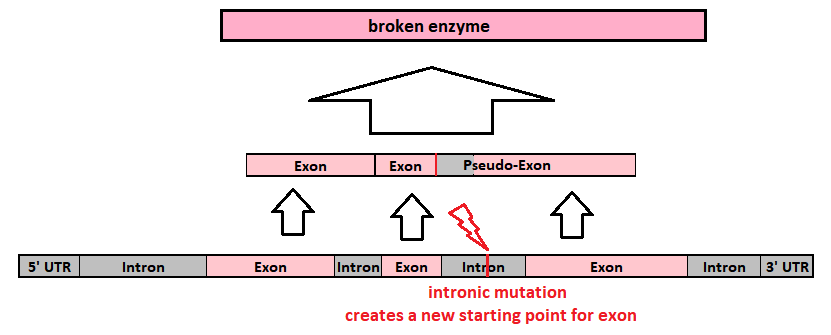(see also splicing)
To explain intronic variants, the structure of a gene must be briefly explained. Here a rough simplification is deliberately chosen! Further explanations can be found on Wikipedia (links are in the text).
DNA is a sequence of nucleotides (the base pairs) that contains the genetic information of an organism.
A gene is a section of DNA that contains basic information for cell function or similar. In the case of Fabry, for example, it is the information on how the enzyme alpha-galactosidase is produced (GLA gene). The gene consists of different parts. Roughly simplified, there is a start-point, then come alternating introns and exons, finally a stop-point.
Introns are regions that do not contain information for the final product, but they can have an influence on the process of enzyme production. The exons contain the actual blueprint for the enzyme.

(5′ UTR and 3′ UTR are the technical terms for the beginning and end of the gene).
When the enzyme is created, the gene is “read”, the introns are separated out, and the exons are used to produce the enzyme.

The cell distinguishes what is intron and what is exon on the basis of certain sequences of nucleotides (base pairs), the intron-exon junctions.
Theoretically, a variant within an intron would have no influence on the final enzyme, since this region is “read over” or deleted before the enzyme is created on the basis of the exons. This is also the opinion of most Fabry specialists. Unfortunately, there is a small problem. If the transitions between intron and exon are broken or a mutation within an intron suddenly creates a new starting point for an exon, then there is wrong information, although the actual blueprint is correct.
I.e.: not every intronic variant has an influence on the finished enzyme, but it cannot be excluded.

Since the introns make up the major part of a gene, but are not usually detected in genetic testing for Fabry disease, there is a relatively high probability that disease-causing intronic variants will also be missed. Thus, when a genetic defect such as Fabry disease is suspected, the introns should always be tested as well.
This explanation is very simplified and there are other effects that can result from intronic mutations. We are happy to provide literature references on request. For the interested reader without genetics education, this text gives a good impression of the topic.
More information can also be found in our blog entry for iontronic mutations.